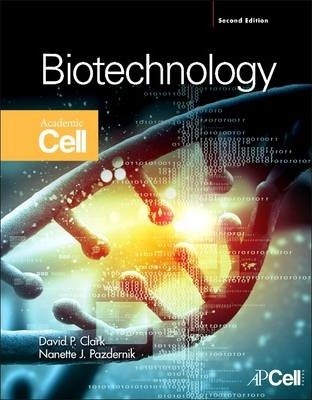Biotechnology
Original price was: ₹9,650.00.₹7,720.00Current price is: ₹7,720.00.
ISBN: 9780123850157
Author/Editor: David P Clark
Publisher: Elsevier
Year: 2015
2 in stock (can be backordered)
Description
Biotechnology, Second Edition approaches modern biotechnology from a molecular basis, which has grown out of increasing biochemical understanding of genetics and physiology. Using straightforward, less-technical jargon, Clark and Pazdernik introduce each chapter with basic concepts that develop into more specific and detailed applications. This up-to-date text covers a wide realm of topics including forensics, bioethics, and nanobiotechnology using colorful illustrations and concise applications. In addition, the book integrates recent, relevant primary research articles for each chapter, which are presented on an accompanying website. The articles demonstrate key concepts or applications of the concepts presented in the chapter, which allows the reader to see how the foundational knowledge in this textbook bridges into primary research. This book helps readers understand what molecular biotechnology actually is as a scientific discipline, how research in this area is conducted, and how this technology may impact the future.
Up-to-date text focuses on modern biotechnology with a molecular foundation
Includes clear, color illustrations of key topics and concept
Features clearly written without overly technical jargon or complicated examples
Provides a comprehensive supplements package with an easy-to-use study guide, full primary research articles that demonstrate how research is conducted, and instructor-only resources
Additional information
| Weight | 2.56 kg |
|---|
Product Properties
| Year of Publication | 2015 |
|---|---|
| Table of Contents | Chapter 1. Basics of Biotechnology Advent of the Biotechnology Revolution Chemical Structure of Nucleic Acids Packaging of Nucleic Acids Bacteria as the Workhorses of Biotechnology Escherichia coli Is the Model Bacterium Many Bacteria Contain Plasmids Other Bacteria in Biotechnology Basic Genetics of Eukaryotic Cells Yeast and Filamentous Fungi in Biotechnology Yeast Mating Types and Cell Cycle Multicellular Organisms as Research Models Animal Cell Culture in Vitro Arabidopsis thaliana, a Model Flowering Plant Viruses Used in Genetics Research Subviral Infectious Agents and Other Gene Creatures Summary Chapter 2. DNA, RNA, and Protein The Central Dogma of Molecular Biology Transcription Expresses Genes Making RNA Transcription Stop Signals The Number of Genes on an mRNA Varies Eukaryotic Transcription is More Complex Regulation of Transcription in Prokaryotes Regulation of Transcription in Eukaryotes Eukaryotic mRNA is Processed Before Making Protein Translating the Genetic Code into Proteins Differences between Prokaryotic and Eukaryotic Translation Mitochondria and Chloroplasts Synthesize Their Own Proteins Summary Chapter 3. Recombinant DNA Technology DNA Isolation and Purification Electrophoresis Separates DNA Fragments by Size Restriction Enzymes Cut DNA; Ligase Joins DNA Methods of Detection for Nucleic Acids Complementary Strands Melt Apart and Reanneal Hybridization of DNA or RNA in Southern and Northern Blots Fluorescence in Situ Hybridization (FISH) General Properties of Cloning Vectors Specific Types of Cloning Vectors Getting Cloned Genes into Bacteria by Transformation Constructing a Library of Genes Screening the Library of Genes by Hybridization Eukaryotic Expression Libraries Features of Expression Vectors Recombineering Increases the Speed of Gene Cloning Gateway?Cloning Vectors Summary Chapter 4. DNA Synthesis In Vivo and In Vitro Introduction Replication of DNA Comparing Replication in Gene Creatures, Prokaryotes, and Eukaryotes In Vitro DNA Synthesis Chemical Synthesis of DNA Chemical Synthesis of Complete Genes Polymerase Chain Reaction Uses in Vitro Synthesis to Amplify Small Amounts of DNA Modifications of Basic PCR Reverse Transcriptase PCR PCR in Genetic Engineering PCR of DNA can Determine the Sequence of Bases Next-Generation Sequencing Technologies Summary Chapter 5. RNA-Based Technologies Noncoding RNA Plays Many Roles RNA Coordinates Genomic Integrity in Eukaryotes RNA Protects Genomes from Invading Viruses RNA Modulates Transcription Noncoding RNAs Take Part in RNA Processing Riboswitches are Controlled by Effector Molecules RNA Catalyzes Enzyme Reactions Summary Chapter 6. Immune Technology Introduction Antibodies, Antigens, and Epitopes The Great Diversity of Antibodies Structure and Function of Immunoglobulins Monoclonal Antibodies for Clinical Use Humanization of Monoclonal Antibodies Humanized Antibodies in Clinical Applications Antibody Engineering Diabodies and Bispecific Antibody Constructs ELISA Assay The ELISA as a Diagnostic Tool Visualizing Cell Components using Antibodies Fluorescence-Activated Cell Sorting Immune Memory and Vaccination Creating a Vaccine Making Vector Vaccines using Homologous Recombination Reverse Vaccinology Identifying New Antigens for Vaccines DNA Vaccines Bypass the need to Purify Antigens Edible Vaccines Summary Chapter 7. Nanobiotechnology Introduction Visualization at the Nanoscale Scanning Tunneling Microscopy Atomic Force Microscopy Weighing Single Bacteria and Virus Particles Nanoparticles and Their Uses Nanoparticles for Labeling Quantum Size Effect and Nanocrystal Colors Nanoparticles for Delivery of Drugs, DNA, or RNA Nanoparticles in Cancer Therapy Assembly of Nanocrystals by Microorganisms Nanotubes Antibacterial Nanocarpets Detection of Viruses by Nanowires Ion Channel Nanosensors Nanoengineering of DNA DNA Origami DNA Mechanical Nanodevices Controlled Denaturation of DNA by Gold Nanoparticles Controlled Change of Protein Shape by DNA Biomolecular Motors Summary Chapter 8. Genomics and Gene Expression Introduction Genetic Mapping Techniques Gaps Remain in the Human Genome Survey of the Human Genome Noncoding Components of the Human Genome Bioinformatics and Computer Analysis Medicine and Genomics DNA Accumulates Mutations over Time Genetic Evolution From Pharmacology to Pharmacogenetics Gene Expression and Microarrays Making DNA Microarrays Hybridization ON DNA Microarrays Monitoring Gene Expression Using Whole-Genome Tiling Arrays Monitoring Gene Expression by RNA-Seq Monitoring Gene Expression of Single Genes Epigenetics and Epigenomics Epigenomics in Higher Organisms Summary Chapter 9. Proteomics Introduction Gel Electrophoresis of Proteins Western Blotting of Proteins High-Pressure Liquid Chromatography Separates Protein Mixtures Digestion of Proteins by Proteases Mass Spectrometry for Protein Identification Preparing Proteins for Mass Spectroscopy Protein Quantification Using Mass Spectrometry Protein Tagging Systems Phage Display Library Screening Protein Interactions: The Yeast Two-Hybrid System Protein Interactions by Co-immunoprecipitation Protein Arrays Metabolomics Summary Chapter 10. Recombinant Proteins Proteins and Recombinant DNA Technology Expression of Eukaryotic Proteins in Bacteria Insulin and Diabetes Cloning and Genetic Engineering of Insulin Translation Expression Vectors Codon Usage Effects Avoiding Toxic Effects of Protein Overproduction Inclusion Bodies and Protein Refolding Increasing Protein Stability Improving Protein Secretion Protein Fusion Expression Vectors Protein Glycosylation Expression of Proteins by Eukaryotic Cells Expression of Proteins by Yeast Expression of Proteins by Insect Cells Expression of Proteins by Mammalian Cells Expression of Multiple Subunits in Mammalian Cells Comparing Expression Systems Summary Chapter 11. Protein Engineering Introduction Engineering Disulfide Bonds Improving Stability In Other Ways Changing Binding Site Specificity Structural Scaffolds Directed Evolution Recombining Domains DNA Shuffling Combinatorial Protein Libraries Creation of De Novo Proteins Expanding the Genetic Code Roles of Non-Natural Amino Acids Biomaterials Design Relies on Protein Engineering Engineered Binding Proteins Summary Chapter 12. Environmental Biotechnology Introduction Identifying New Genes with Metagenomics Culture Enrichment for Environmental Samples Sequence-Dependent Techniques for Metagenomics Function- or Activity-Based Evaluation of The Environment Ecology and Metagenomics Natural Attenuation of Pollutants Biofuels and Bioenergy Microbial Fuel Cells Summary Chapter 13. Synthetic Biology Introduction Ethanol, Elephants, and Pathway Engineering Degradation of Starch Degradation of Cellulose Second-Generation Biofuels Biodiesel Ice-Forming Bacteria and Frost Biorefining of Fossil Fuels Biosynthesis of ?-Lactam Antibiotics Biosynthetic Plastics are Also Biodegradable The Integrated Circuits Approach Synthetic Genetic Materials: xDNA And XNA Designer Bacteria Summary Chapter 14. From Cell Phones to Cyborgs Introduction Cell Phones Robotics Radio-Controlled Genes Insect Cyborgs Soft Robotics Summary Chapter 15. Transgenic Plants and Plant Biotechnology Introduction History of Plant Breeding Plant Tissue Culture Genetic Engineering of Plants Biotechnology Improves Crops Resistance: Nature Responds to Transgenic Plants Functional Genomics in Plants Summary Chapter 16. Transgenic Animals New and Improved Animals Creating Transgenic Animals Larger Mice Illustrate Transgenic Technology Recombinant Protein Production Using Transgenic Livestock Knockout Mice for Medical Research Alternative Ways to Make Transgenic Animals Location Effects on Expression of the Transgene Deliberate Control of Transgene Expression Gene Control by Site-Specific Recombination Transgenic Insects Practical Transgenic Animals Applications of RNA Technology in Transgenics Natural Transgenics and DNA Ingestion Summary Chapter 17. Inherited Defects and Gene Therapy Introduction Hereditary Defects in Higher Organisms Hereditary Defects Due to Multiple Genes Defects Due to Haploinsufficiency Dominant Mutations may be Positive or Negative Deleterious Tandem Repeats and Dynamic Mutations Defects in Imprinting and Methylation Mitochondrial Defects Identification of Defective Genes Genetic Screening and Counseling General Principles of Gene Therapy Adenovirus Vectors in Gene Therapy Cystic Fibrosis Cystic Fibrosis Gene Therapy Retrovirus Gene Therapy Retrovirus Gene Therapy for Scid Adeno-Associated Virus Nonviral Delivery in Gene Therapy Liposomes and Lipofection in Gene Therapy Aggressive Gene Therapy for Cancer Using RNA in Therapy Antisense RNA and Other Oligonucleotides Aptamers?locking Proteins with DNA or RNA Ribozymes in Gene Therapy RNA Interference in Gene Therapy Gene Editing with Nucleases Genome Editing with Engineered Nucleases Genome Editing with CRISPR Nucleases Summary Chapter 18. Cloning and Stem Cells Introduction What is a Stem Cell? Identifying Adult Stem Cells The Key Features of a Stem Cell Niche Hematopoietic Stem Cells in the Bone Marrow Intestinal Epithelial Stem Cells Induced Pluripotent Stem Cells Stem Cell Therapy Somatic Cell Nuclear Transfer Dolly the Cloned Sheep Practical Reasons for Cloning Animals Improving Livestock by Pathway Engineering Imprinting and Developmental Problems in Cloned Animals Summary Chapter 19. Cancer Cancer is Genetic in Origin Environmental Factors and Cancer Normal Cell Division: The Cell Cycle Cellular Communication Receptors and Signal Transmission Cell Division Responds to External Signals Genes that Affect Cancer Oncogenes and Proto-Oncogenes Detection of Oncogenes by Transformation Types of Mutations that Generate Oncogenes The RAS Oncogene?yperactive Protein The MYC Oncogene?verproduction of Protein Tumor-Suppressor Genes or Anti-Oncogenes The p16, p21, and p53 Anti-Oncogenes Formation of a Tumor Inherited Susceptibility to Cancer Cancer-Causing Viruses Engineered Cancer-Killing Viruses Cancer Genomics Cancer Epigenomics Micro RNA Regulation and Cancer Anticancer Agents Summary Chapter 20. Aging and Apoptosis Introduction Genetic Phenomena Associated with Aging Cellular Dysfunction and Aging Cellular Senescence Programmed Cell Death Apoptosis Involves a Proteolytic Cascade Mammalian Apoptosis Caspases Execution Phase of Apoptosis Corpse Clearance in Apoptosis Control of Apoptotic Pathways in Development Necroptosis Metabolic Control of Cell Death Cancer, Aging, and Programmed Cell Death Programmed Cell Death in Bacteria Summary Chapter 21. Viral and Prion Infections Viral Infections and Antiviral Agents Interferons Coordinate the Antiviral Response Antiviral Therapy using RNA Interference Influenza is a Negative-Strand Rna Virus The AIDS Retrovirus Chemokine Receptors Act as Co-Receptors for Hiv Treatment of the AIDS Retrovirus Infectious Prion Disease Detection of Pathogenic Prions Approaches to Treating Prion Disease Prions in Yeast Using Yeast Prions as Models Amyloid Proteins in Neurological Diseases Summary Chapter 22. Biological Warfare: Infectious Disease and Bioterrorism Introduction The Natural History of Biological Warfare Microbes Versus Man: The Rise of Antibiotic Resistance A Brief History of Human Biological Warfare Identifying Suitable Biological Warfare Agents A Closer Look at Select Biological Warfare Agents Enhancing Biological Warfare Agents with Biotechnology Detection of Biological Warfare Agents Summary Chapter 23. Forensic Molecular Biology The Genetic Basis of Identity Blood, Sweat, and Tears Forensic DNA Testing DNA Fingerprinting Using Repeated Sequences in Fingerprinting Probability and DNA Testing The Use of DNA Evidence DNA is Also Used to Identify Animals Tracing Genealogies by Mitochondrial DNA and the Y Chromosome Identifying the Remains of the Russian Imperial Family Gene Doping and Athletics Genomics Drives Advances in Forensics Summary Chapter 24. Bioethics in Biotechnology Introduction Principles of Bioethics Use of the Precautionary Principle The Power of Information Possible Dangers to Health from Biotechnology Genetically Modified Organisms Human Enhancement, Cloning, and Engineering Ethics Changes over Time Summary |
| Author | David P Clark |
| ISBN/ISSN | 9780123850157 |
| Binding | Hardback |
| Edition | 2 |
| Publisher | Elsevier |
You must be logged in to post a review.






Reviews
There are no reviews yet.